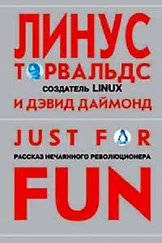And it's obvious that both mother and daughter stay abreast of that hullabaloo. It is late January 2000, the day following Transmeta's big public announcement of what it has been up to, and early in our lunch, Mikke asks Sara, "Was there anything in the paper today about you-know-who and you-know-what?"
That night, on her way to work, Mikke asks her taxi to wait outside my hotel while she drops off a pine child's chair she'd like me to hand-deliver to Patricia. That, and a floor plan of the available apartment for Linus.
About my first memory of Linus doing something remarkable.
I think it was early 1992. I was visiting Linus at his completely messy home once again -- by bike and with no agenda. While watching MTV, as usual, I asked about Linus's operating -- system development. Normally he answered somethinq meaningless. This time, he led me to his computer (from Torvalds' messy kitchen to his totally chaotic room).
Linus gave the computer his username and password and got to a command prompt. He showed some basic functionality of the command interpreter -- nothing special, though. After awhile, he turned to me with a Linus grin on his face and asked: "It looks like DOS, doesn't it?"
I was impressed and nodded. I wasn't stunned, because it looked like DOS too much -- with nothing new, really. I should have known Linus never grins that way without a good reason. Linus turned back to his computer and pressed some function key combination -- another login screen appeared. A new login and a new command prompt. Linus showed me four individual command prompts and explained that later they could be accessed by four separate users.
That was the moment I knew Linus had created something wonderful. I have no problem with that -- I still dominate the snooker table.
Jouko "Avuton" Vierumaki
For me, it meant mainly that the phone lines were constantly busy and nobody could call us... At some point, postcards began arriving from different corners of the globe. I suppose that's when I realized people in the real world were actually using what he had created.
Sara Torvalds
V. The Beauty of Programming
I don't know how to really explain my fascination with programming, but I'll try. To somebody who does it, it's the most interesting thing in the world. It's a game much more involved than chess, a game where you can make up your own rules and where the end result is whatever you can make of it.
And yet, to the outside, it looks like the most boring thing on Earth.
Part of the initial excitement in programming is easy to explain: just the fact that when you tell the computer to do something, it will do it. Unerringly. Forever. Without a complaint.
And that's interesting in itself.
But blind obedience on its own, while initially fascinating, obviously does not make for a very likable companion. In fact, that part gets pretty boring fairly quickly. What makes programming so engaging is that, while you can make the computer do what you want, you have to figure out how .
I'm personally convinced that computer science has a lot in common with physics. Both are about how the world works at a rather fundamental level. The difference, of course, is that while in physics you're supposed to figure out how the world is made up, in computer science you create the world. Within the confines of the computer, you're the creator. You get to ultimately control everything that happens. If you're good enough, you can be God. On a small scale.
And I've probably offended roughly half the population on Earth by saying so.
But it's true. You get to create your own world, and the only thing that limits what you can do are the capabilities of the machine -- and, more and more often these days, your own abilities.
Think of a treehouse. You can build a treehouse that is functional and has a trapdoor and is stable. But everybody knows the difference between a treehouse that is simply solidly built and one that is beautiful, that takes creative advantage of the tree. It's a matter of combining art and engineering. This is one of the reasons programming can be so captivating and rewarding. The functionality often is second to being interesting, being pretty, or being shocking.
It is an exercise in creativity.
The thing that drew me into programming in the first place was the process of just figuring out how the computer worked. One of the biggest joys was learning that computers are like mathematics: You get to make up your own world with its own rules. In physics, you're constrained by existing rules. But in math, as in programming, anything goes as long as it's self-consistent. Mathematics doesn't have to be constrained by any external logic, but it must be logical in and of itself. As any mathematician knows, you literally can have a set of mathematical equations in which three plus three equals two. You can do anything you want to do, in fact, but as you add complexity, you have to be careful not to create something that is inconsistent within the world you've created. For that world to be beautiful, it can't contain any flaws. That's how programming works.
One of the reasons people have become so enamored with computers is that they enable you to experience the new worlds you can create, and to learn what's possible. In mathematics you can engage in mental gymnastics about what might be. For example, when most people think of geometry, they think of Euclidean geometry. But the computer has helped people visualize different geometries, ones that are not at all Euclidean. With computers, you can take these made-up worlds and actually see what they look like. Remember the Mandelbrot set -- the fractal images based on Benoit Mandelbrot's equations? These were visual representations of a purely mathematical world that could never have been visualized before computers. Mandelbrot just made up these arbitrary rules about this world that doesn't exist, and that has no relevance to reality, but it turned out they created fascinating patterns. With computers and programming you can build new worlds and sometimes the patterns are truly beautiful.
Most of the time you're not doing that. You're simply writing a program to do a certain task. In that case, you're not creating a new world but you are solving a problem within the world of the computer. The problem gets solved by thinking about it. And only a certain kind of person is able to sit and stare at a screen and just think things through. Only a dweeby, geeky person like me.
The operating system is the basis for everything else that will happen in the machine. And creating one is the ultimate challenge. When you create an operating system, you're creating the world in which all the programs running the computer live -- basically, you're making up the rules of what's acceptable and can be done and what can't be done. Every program does that, but the operating system is the most basic. It's like creating the constitution of the land that you're creating, and all the other programs running on the computer are just common laws.
Sometimes the laws don't make sense. But sense is what you strive for. You want to be able to look at the solution and realize that you came to the right answer in the right way.
Remember the person in school who always got the right answer? That person' did it much more quickly than everybody else, and did it because he or she didn't try to. That person didn't learn how the problem was supposed to be done but, instead, just thought about the problem the right way. And once you heard the answer, it made perfect sense.
The same is true in computers. You can do something the brute force way, the stupid, grind-the-problem-down-until-it's-not-a-problem-anymore way, or you can find the right approach and suddenly the problem just goes away. You look at the problem another way, and you have this epiphany: It was only a problem because you were looking at it the wrong way.
Читать дальше












